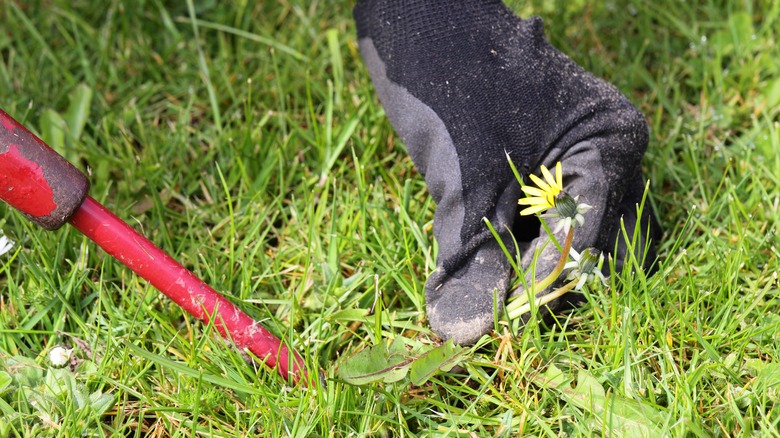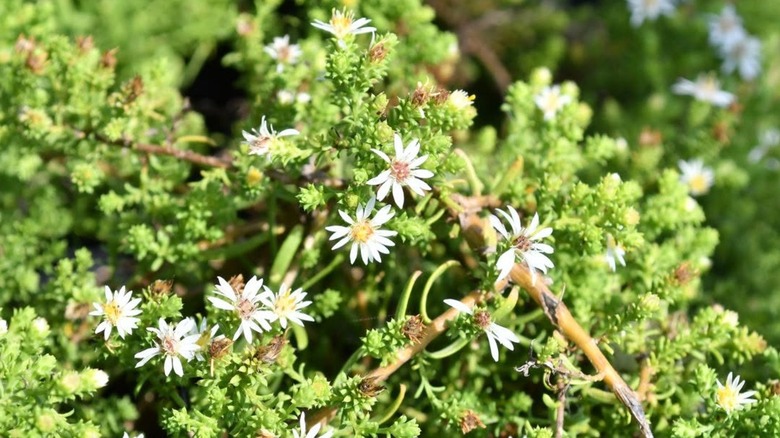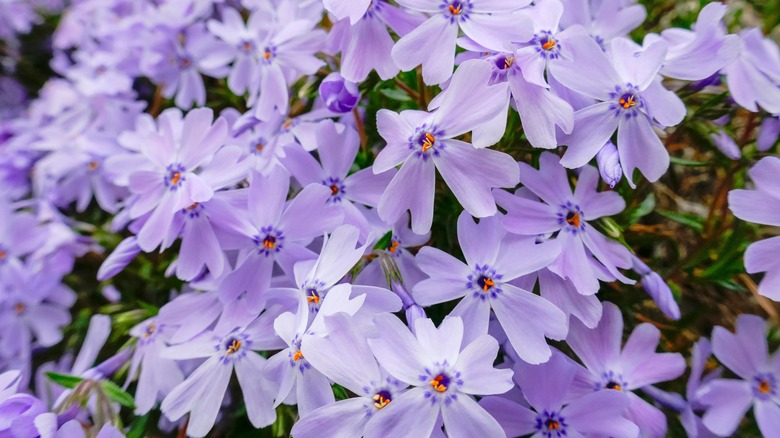12 Easy-To-Grow Ground Covers To Smother Weeds In Your Yard And Garden
Landscaping yards and gardens would be more fun if weeds weren't a persistent problem. Unfortunately, they've found myriad ways to trespass and snag precious real estate. While you could put an end to their colonization of your yard's bald or thinning patches by laying down mulch, it involves quite a bit of labor and cash. Herbicides are a no-go when you factor in the environmental damage. Fortunately, there is a better option to smother weeds without breaking the bank: ground cover plants, but to ensure they keep the unwanted guests out, they must establish a dense mat, preferably evergreen, like 'Walkers low' catmint or moss phlox. Otherwise, the weeds, along with their seeds, rhizomes, or other propagative material, will find wiggle room rather than being shaded out.
There are a few caveats to treading the "groundcovers for weed suppression" route. Fast-growing ground covers can become aggressive in optimal conditions. However, they can be fended off by edging or interplanting with a similarly assertive ground cover so they keep each other in check. Resist the temptation to start ground covers with seeds, as telling them apart from weed seedlings can be difficult. Plus, the gestation period empowers weeds to take over. Also, limit your expectations. Since birds, lawn equipment, foot traffic, and wind continue to disperse weed seeds, having to pull out new volunteers now and then is unavoidable. That being said, read on to discover easy-to-grow ground covers that can smother your yard's weeds.
1. Plumbago
Plumbago (Ceratostigma plumbaginoides) is a blue-flowering plant that'll help keep weeds out of the garden and a step up from wood mulch. It creeps over 1 ½ feet across via rhizomes, quickly covering bare areas. Unfortunately, it's prone to dying back in freezing temperatures (zone 5). This limits its utility if there's no reliable snow cover to make up for the shed foliage. Though, retaining old stems may provide some respite, especially in light of its late spring green-up. It isn't touchy about the soil's texture, pH, or fertility and tolerates full-to-part sunlight. Any volunteers can be dug out easily.
2. White heath aster 'Snow Flurry'
White heath asters (Aster ericoides) may not be your first choice for a ground cover, but its 'Snow Flurry' cultivar will have you reconsidering. It grows no further than 6 inches in height and teems out impenetrably, depriving weeds of all berths. Plus, it gives off the appearance of a stiff-leaved creeping juniper when it isn't flowering white petals or dotted by butterflies in the summer. 'Snow Flurry' holds its own in shallow-rocky and dry soils, making it perfect for rock gardens. However, it'll adapt to clay and poor soils with full sun.
3. Catmint 'Walker's Low'
You might know catmint's (Nepeta x faassenii) cultivar 'Walker's Low' as a fast-growing ground cover that'll attract hummingbirds and pollinators to your yard. However, it's just as effective as a weed suppressant once it has rooted in your sunny or moderately shaded site. It isn't a low grower, measuring over 2 feet tall and wide. But it outpaces its competition by refusing to spread aggressively — its seeds are sterile, after all. It's unbothered by drought, urban pollution, herbivory, and soil pH, spotlighting its easy-to-grow nature. Cats may become curious about its silvery-green foliage.
4. Moss phlox 'Emerald Blue'
Moss phlox (Phlox subulata) is quite popular in the gardening realm as an ornamental ground cover that greedily covers bare ground, leaving no leeway for weeds. Its cultivar 'Emerald Blue' doesn't disappoint, considering it's winter hardy through zone 2. So long as you promise copious sun exposure (with some afternoon shade in warmer climates), 'Emerald Blue' will enthrall you with butterfly-friendly bluish-purple flowers and sturdy stems that mat out 3 feet across. To keep its 6-inch-high mound bushy, consider trimming its stems once the flowering season ends.
5. Two-row stonecrop 'John Creech'
Gardeners saddled with dry, gravelly, or poor soils should grow 'John Creech,' a self-fertile cultivar of two-row stonecrop (Phedimus spurius, previously Sedum spurium). Since it's a succulent, 'John Creech' has no major watering requirements for exhibiting its sculptural leaves or pink flowers. While it usually tops out at 2 inches, it's quick to send out runners and establish a 1-foot-thick carpet, choking out most weeds and checking erosion. It maintains evergreen foliage in warmer parts of USDA zones 3 through 8. Plonk it in the sunniest site, but remember that it can stomach some shade.
6. Creeping juniper
True to its name, creeping juniper (Juniperus horizontalis) crawls along the ground, directing its stems 10 feet across. Resultantly, it institutes an impermeable carpet that denies weeds passage. Drought, salt, heat, or pollution are unlikely to be its undoing. Better yet, varying soil textures or pH levels don't play spoilsport. To enjoy its bluish-green, needled evergreen foliage, ensure it's exposed to a minimum of six hours of direct sunlight. Well-draining soils in growth zones 3 through 9 are a must. Cultivars like 'Wiltonii' and 'Blue Rug' offer compact, cold-hardy matting. However, watch out for blights.
7. Eastern columbine
Eastern columbine's (Aquilegia canadensis) mature size of 3 feet might not exactly scream "ground cover." But, after its clouds of tubular yellow and red flowers have accomplished the deed of luring hummingbirds and butterflies into your yard, they turn into a low-grower. And you'll be thankful for it, as they can keep even the most persistent weeds out (like woodsorrel). Allowing them to go to seed ensures they make new plants, gaining a foothold in the area while keeping birds fed. However, since they're deciduous, either spread mulch or ensure the space will receive reliable snow cover before planting.
8. Coral bells 'Chocolate Ruffles'
Combating weeds doesn't always have to be green; sometimes, you should go purple. Coral bells' (Heuchera americana) hybrid cultivar 'Chocolate Ruffles' is a ruffled delight with its coppery-pink leaves that mature into chocolatey-burgundy hues. With its purple flower spikes, it stands as a 2-foot-tall clump and will nab space in the yard as a fast-growing ground cover so long it receives part-to-full sunlight. Although hardy in USDA zones 4 to 9, it retains its evergreen character only in mild winters, going semi-evergreen when the temperatures dip too low.
9. Autumn goldenrod 'Golden Fleece'
Unlike the straight autumn goldenrod (Solidago sphacelata) species it was fashioned out of, 'Golden Fleece' has better control of its spreading tendencies. Simply put, it self-seeds and roots where its rhizomes touch the soil, thereby deterring a weedy takeover — without becoming unruly itself. Deadheading faded blooms before they set seeds should further keep the ground cover contained. 'Golden Fleece' grows nearly 1 ½ feet tall and 3 feet across, adding late-summer interest via its yellow flowers atop heart-shaped foliage. Give it full sun or partial shade and good drainage. It tolerates dry, poor, and clay soils.
10. Blue wood sedge
Desire a plant that will flood your rain garden with abundance without attracting the ire of weeds? Consider southeastern U.S. native: blue wood sedge (Carex flaccosperma) or thinfruit sedge. It spreads around 1 foot across, establishing a dense clump of evergreen bluish-green foliage. In summer, this deer-resistant sedge gets topped by whitish-green flowers that may not hold much ornamental value for gardeners but will please butterflies and songbirds immensely. As it's prone to leaf scorch in full sun exposure, it's best popped in shaded spots — even deep shade. However, it's considered invasive in Alexandria, VA.
11. Butterfly weed
Butterfly weed (Asclepias tuberosa) is a plant that will fill your garden with a variety of butterflies and keep weeds out after it has settled. Depending on its location in USDA zones 3 through 9, it can grow between 1 and 2½ feet tall. Though, you would be better served trimming its stems before spring heralds in. Butterfly weeds are only concerned with full sun exposure and good drainage. After establishing, they'll tolerate salt sprays, drought stress, and poor fertility. Start with cuttings, as seeds take over two years to flower. Remove seed pods to keep them contained.
12. Mrs. Robb's hatbox
Collected and introduced by Botanist Mary Ann Robb, Mrs. Robb's hatbox is an evergreen subspecies of wood spurge — hence why it's botanically titled Euphorbia amygdaloides, 'robbiae.' However, she outsmarts wood spurge by shooting out rhizomes far more profusely, enabling a quick establishment of over 1½ feet wide ground cover. In addition, her black-green blades adopt gorgeous burgundy or lavender hues during the fall, rendering massive decorative value. Hardy through zone 6, Mrs. Robb's hatbox can survive in dappled and partial shade. Remove dead blooms to repress her self-seeding tendencies.












